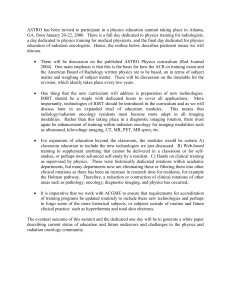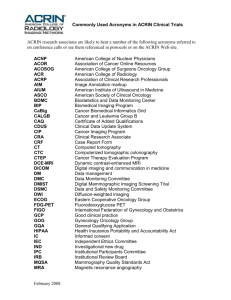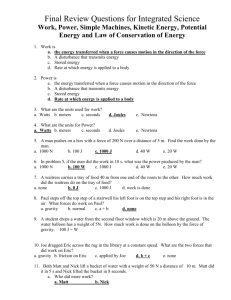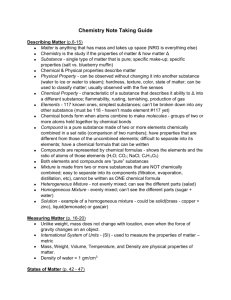Implementing SBRT Protocols: A NRG CIRO Perspective Ying Xiao, Ph.D.
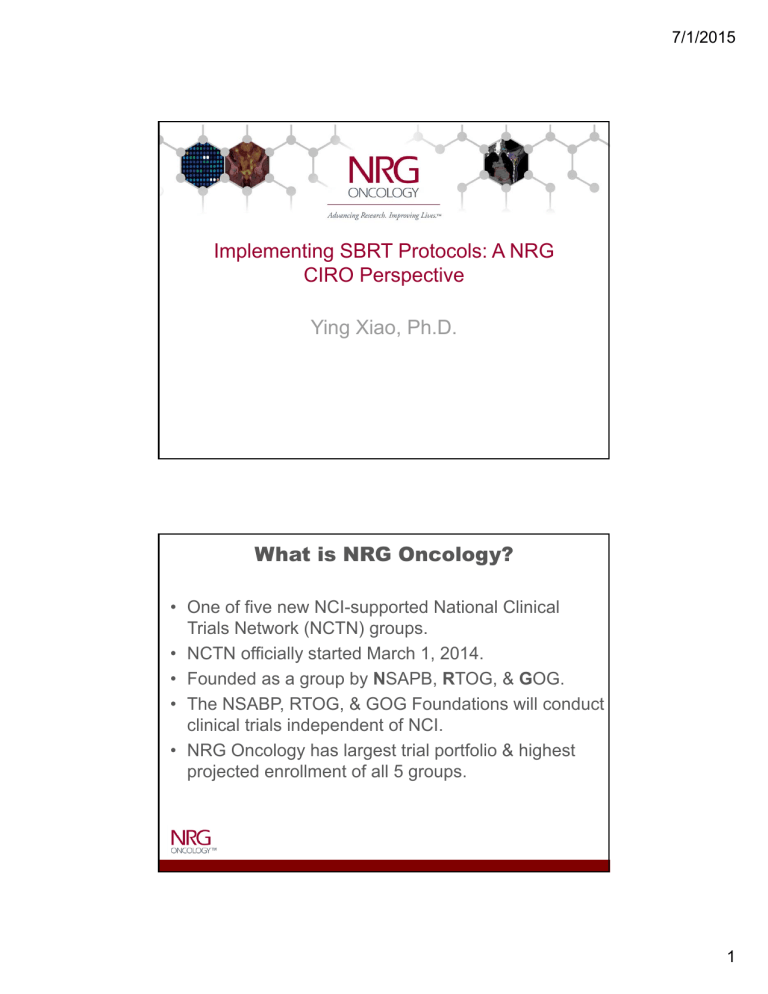
Implementing SBRT Protocols: A NRG
CIRO Perspective
Ying Xiao, Ph.D.
What is NRG Oncology?
• One of five new NCI-supported National Clinical
Trials Network (NCTN) groups.
• NCTN officially started March 1, 2014.
• Founded as a group by N SAPB, R TOG, & G OG.
• The NSABP, RTOG, & GOG Foundations will conduct clinical trials independent of NCI.
• NRG Oncology has largest trial portfolio & highest projected enrollment of all 5 groups.
7/1/2015
1
7/1/2015
Group Enrollment 2006-2010
3,100
Institutions
14,000
Investigators
About
25,000 pts enrolled on tx trials annually
Trials
All
Phases:
Treatment
Trials
FY200
6
27,667
FY2007
24,715
FY2008
25,784
FY200
9
29,285
FY2010
23,468
Accrual
Distribution:
Phase 3: 83.4%
Phase 2: 15.1%
Phase 1/Pilot: 1.5%
2
7/1/2015
5 NRG Oncology Specific Aims
Improve the lives of adult patients with localized or locally advanced cancers through the conduct of high quality NCIsupported multi-institutional clinical trials;
3
5 NRG Oncology Specific Aims
Conduct practice-defining research for the major gender-specific malignancies
(breast & gynecologic cancers & prostate cancer) while capitalizing on common biologic features and interactive research opportunities among these diseases;
7/1/2015
5 NRG Oncology Specific Aims
Investigate new developments in medical technology , including radiation oncology, imaging, surgical technology, & IT, for opportunities to advance the care of patients with localized / locally advanced cancers;
4
5 NRG Oncology Specific Aims
Integrate and expand the legacy groups’ translational science programs to better inform biomarker- and biologic pathway-defined approaches to risk stratification, investigational therapy assignment, & clinical trial decisionmaking
;
7/1/2015
5 NRG Oncology Specific Aims
Selectively expand GOG’s developmental therapeutics program to NRG’s other six cancer disease site committees to further strengthen the selection of investigational approaches for phase II & III trials.
5
NRG Oncology
Center for Innovation in Radiation
Oncology
(CIRO)
NRG Committee Structure
7/1/2015
6
Aims of CIRO
• Promote innovative RT research within all NCTN
• Accelerate testing new rad onc innovations in NCTN
• Facilitate innovation in all appropriate protocols
• Foster intergroup & protocol harmonization
• Reduce timelines for development of new protocols
• Improve the clarity of NCTN protocols
7/1/2015
NRG/RTOG 0617: Survival by RT Dose
100
75
50
25
Dead
90
117
Total
213
206
Median
Survival Time
28.7
months
19.5
months
0
0
Patients at Risk
Standard
High dose
213
206
3
207
197
6 9 12
Months since Randomization
190
178
177
159
161
135
15
141
112
18
108
87
18 ‐ Month
Survival
Rate
66.9%
53.9%
7
PET ‐ Adapted Radiation Therapy
NRG/RTOG 1106
~3 wks
(47.5
Gy/19 fx @ 2.5
Gy/fx)
NRG/RTOG 1106-Adaptive RT for Stage III NSCLC Pts
NRG/RTOG 1106 tests the efficacy of during-RT PET-
MTV based individualized radiation dose escalation.
Inoperable or unresectable
Stage III
NSCLC
(FDG-
PET/CT staged)
FDG
PET/
CT based
RT plan to 74
Gy
ED2
I
Z
O
M
N
D
R
A
E
*
1: Conc. chem- RT
50 Gy/25fx
(ED2^=50 Gy)
FDG- PET/CT at 40-
50 Gy ED2^ for all pts
2: Concurrent chem-RT to
ED2^=50 Gy in
17-21 fxs
F-Miso-PET for Selected Institutions
1 : Continue conc. chem-RT to a total of
60 Gy ED2 /37 fxs or MLD of 20 Gy
2: During-RT FDG-
PET/CT adaptive chem-
RT to MLD 20 Gy $ in
2.4-3.5 Gy/fx for 9-13 fxs to a total of 86 Gy
(100 Gy ED2 lung ) /30 fxs
RTOG 0617
Uniform RT prescription
dose
Experimental arm:
Individualized adaptive RT
7/1/2015
8
PET-Adapted Radiation Therapy
Initial PET/CT Mid ‐ Tx PET/CT
NRG/RTOG 1106
~3 wks
Proton Beamline
7/1/2015
9
NRG/RTOG 1308: Phase III Randomized Trial Comparing
Overall Survival after Photon vs Proton Chemo-RT for
Stage II-IIIB NSCLC
Stratify
Stage
1.IIIA
2.IIIB
GTV
1.<= 130 cc
2.>130 cc
Histology
1.Squamous
2.Non-Squamous
Arm 1
Photon: Highest achievable dose between 60 ‐ 70 Gy at 2 Gy, once daily plus platinum ‐ based doublet chemotherapy
Arm 2
Protons: Highest achievable dose between 60 ‐ 70 Gy (RBE) at 2 Gy
(RBE) once daily plus platinum ‐ based doublet chemotherapy
Arms 1 and 2: Consolidation
Chemotherapy x 2 is allowed
Plan must meet dose and volume constraints of all OARs
(very different from other trials)
Heart Dose: Protons vs IMRT
100
80
60
40
20
0
PSPT
Heart V5
IMRT
7/1/2015
10
3D vs Proton for NSCLC
Photon 3D ‐ CRT
Proton
7/1/2015
NRG Oncology Summary
• Amazing Adaptation of NRG Oncology Members to
New System!
• Trials in NCTN Limited by Available Resources
• What are Unintended Consequences of Transition?
• Great Need for Resources in Project Development
• CIRO will be a Critical Resource for NRG and NCTN
11
SBRT Protocols-Past&Present
Examples
• RTOG 0236 – Practice Changing
7/1/2015
12
NRG BR001 Schema
7/1/2015
Legacy RTOG Protocol TOC
13
NRG Protocol TOC
7/1/2015
The Process – SBRT template
14
5.2.1Treatment Technology Requirements
7/1/2015
5.2.2 Immobilization and Simulation
15
7/1/2015
5.2.3Imaging for Structure Definition, Image
Registration/Fusion and Follow-up
Free-Breathing, MIP or AVE?
Tian, Y., Wang, Z., Ge, H., Zhang, T., Cai, J., Kelsey, C., … Yin, F.-F. (2012). Dosimetric comparison of treatment plans based on free breathing, maximum, and average intensity projection CTs for lung cancer SBRT. Medical Physics , 39 (5), 2754. http://doi.org/10.1118/1.4705353
16
5.2.4Definition of Target Volumes and Margins
7/1/2015
5.2.5Definition of Critical Structures and
Margins
17
TRIAD Validation Examples
7/1/2015
Topic/Parameter
5.2.6Treatment Planning Guidelines
Guidelines
Planning Technique
Number of Beams
Beam Arrangement
Beam Energy
3DCRT, conformal arc, and intensity-modulated techniques (IMRT, VMAT) allowed.
Tomographic and robotic techniques also allowed.
As planning dictates although ≥7 beams are recommended for static beam plans due to skin toxicity considerations. Similarly, arcs should cover an appropriate range so as to deliver a safe dose to the skin.
Coplanar or non-planar, non-overlapping, non-opposing beams or arc therapy (non-coplanar arcs allowed). Combination of static and arc beams allowed.
As planning dictates although lower energies preferred for lung
Block Margin (for 3DCRT)
Minimum Field Size
Dataset for Dose
Calculation
Dose Calculation Algorithm
Dose Grid Resolution
0-2 mm
As planning dictates although only the smallest field size accurately commissioned (e.g. small field output factors are within 5% of published standards or values) at the institution should be used. Because of concerns with small field dosimetry, field sizes above 2 cm x 2 cm are preferable.
ITV Approach – Average from 4DCT or normal exhale if 4DCT not available (Free breathing CT is not appropriate)
Breath Hold – CT taken at treatment breath hold
Gated – Average from gating window phases from 4DCT or the median phase in the gating window
Tracking – 4DCT or breath hold CT
Contrast Scans are not recommended for dose calculations. Recommend obtaining a noncontrast scan during simulation for dose calculation. If a contrast scan is used for dose calculation, density/material overrides are recommended when dose calculation accuracy may be affected.
Modern algorithms that accurately handle tissue heterogeneity and scatter should be used.
IROC maintains an updated list of approved algorithms. Density corrections must be applied.
Density overrides of the ITV are not recommended for photon treatment. All doses should be reported in terms of dose-to-water and not in terms of dose-to-medium.
2 mm x 2 mm dose grid resolution or smaller is strongly recommended.
18
7/1/2015
Planning Margin
Cardinale, R. M., Wu, Q., Benedict, S. H., Kavanagh, B. D., Bump, E., & Mohan, R. (1999). Determining the optimal block margin on the planning target volume for extracranial stereotactic radiotherapy. International Journal of Radiation Oncology Biology Physics, 45(2), 515–520. http://doi.org/10.1016/S0360-3016(99)00203-
5
Dose Calculation Algorithm
Devpura, S., Siddiqui, M. S., Chen, D., Liu, D., Li, H., Kumar, S., … Chetty, I. J. (2014). Recommendations for dose calculations of lung cancer treatment plans treated with stereotactic ablative body radiotherapy (SABR).
Journal of Physics: Conference Series
,
6596/489/1/012007
489
, 012007. http://doi.org/10.1088/1742-
19
5.2.7Compliance criteria
7/1/2015
5.2.8 Treatment Planning Priorities and
Instructions
20
5.2.9 Patient specific QA
Any patient-specific QA that needs to be acquired should follow institutional guidelines. For intensity modulated techniques, patient specific QA is highly recommended.
5.2.10Daily Treatment Localization/IGRT
Treatment Technique Acceptable Methods for Daily Image Guidance Matching Instructions
Volumetric Imaging • ITV/free breathing
(includes abdominal
Initial rigid alignment followed by soft tissue match with average CT and slow CBCT
4DCT to 4D-CBCT can be used when capability exists compression)
Volumetric Imaging (i.e. CBCT or CT on rails) is strongly recommended
•
Planar Imaging
If volumetric imaging is not available, then an appropriate tumor surrogate
(i.e. implanted fiducials) must be able to be accurately imaged in the treatment position with 2D imaging. The patient surface is not an appropriate surrogate for tumor setup although surface based imaging may be used during treatment to assess unexpected patient motion.
•
•
• Rigid alignment to bony anatomy
Repeat imaging to ensure tumor surrogate is within ITV
Repeat imaging at each treatment port to ensure tumor surrogate remains within the ITV is very strongly recommended
Note that when orthogonal 2D imaging (with or without implanted fiducials) is employed for sites where respiratory motion is expected and not controlled via motion management techniques, care must be taken to ensure accurate targeting of the ITV within the treatment. For example, static kV imaging at an undetermined breath hold position would not be adequate IGRT for treating a free-breathing lung tumor.
Repeat imaging during treatment is recommended to verify that the tumor is in the ITV
If any significant baseline shifts are noted, resimulation should be strongly considered
The baseline gating position/phase should be verified using appropriate imaging techniques
• Initial rigid alignment followed by soft tissue match for baseline gating position
Gating with a gating window
Volumetric Imaging (i.e. CBCT or CT on rails) is strongly recommended for the initial localization to verify isocenter and tumor trajectory
Gating with breath hold
(ie ABC)
Volumetric imaging recommended; planar at breath hold position acceptable
– repeated imaging recommended to ensure reproducibility of breath hold
• Initial rigid alignment followed by soft tissue match of tumor or surrogate
Tracking
All imaging should be done at breath hold treatment position
Volumetric imaging or real-time fluoroscopic imaging of tumor surrogate required based on treatment machine capabilities.
• Initial rigid alignment followed by soft tissue match of tumor or surrogate in baseline position
7/1/2015
21
IGRT Investigations
Higgins, J., Bezjak, A., Hope, A., Panzarella, T., Li, W., Cho, J. B. C., … Bissonnette, J. P. (2011). Effect of image-guidance frequency on geometric accuracy and setup margins in radiotherapy for locally advanced lung cancer. International Journal of Radiation Oncology Biology Physics , 80 (5), 1330–1337. http://doi.org/10.1016/j.ijrobp.2010.04.006
Summary
• CIRO – the Resource for Implementation of
Advanced Radiation Therapy in Clinical Trials
• SBRT Guidelines from Radiation Oncology
Community Studies
• NRG Protocol Radiation Therapy Sections
Follows Clinical Processes
• We appreciate feed back to improve
7/1/2015
22
7/1/2015
23

